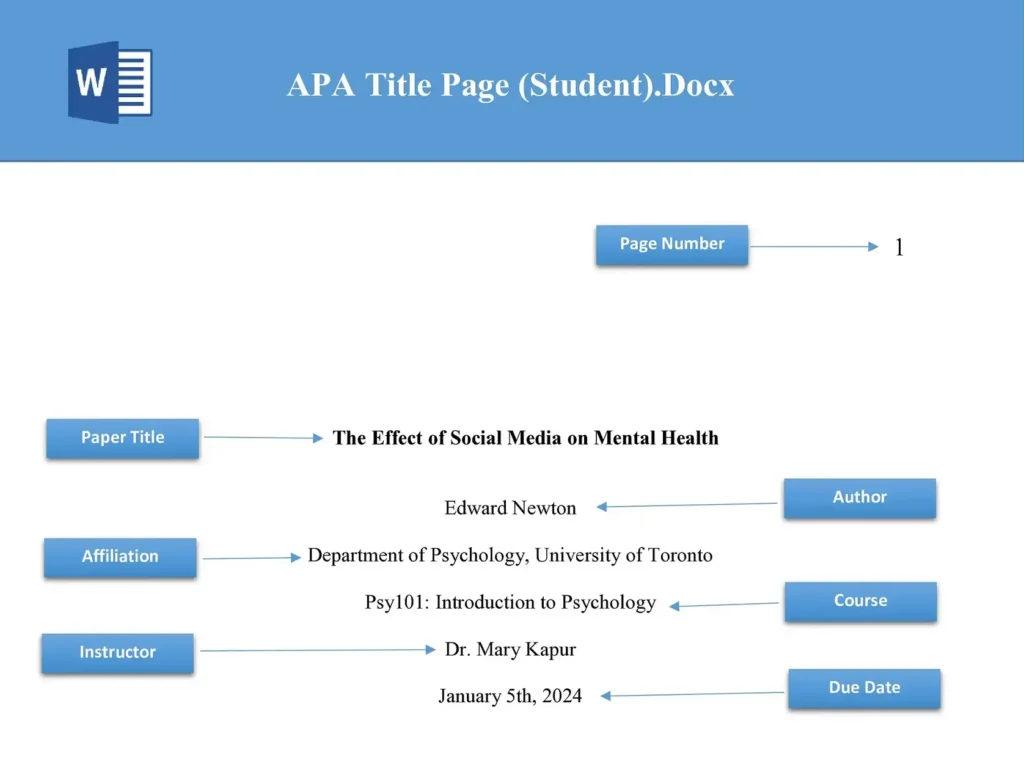Effective research paper formatting plays a crucial role in the overall quality and reception of scholarly work. They are a great addition to your motivational letters. The way information is presented not only reflects the author’s professionalism but also enhances the clarity and accessibility of the research. Proper formatting ensures that the content is organized and adheres to academic standards, contributing to the credibility of the research and the author.
ResearchProspect provides free Microsoft Word templates for commonly used formats. Easily download them with a single click and start working on your paper effortlessly.
This guide describes everything you need to know about research paper formatting. Let’s explore this in detail.
General Guidelines For Research Paper Formatting
Here are some general guidelines for formatting a research paper.
A. Title Page
The title page is the opening representation of your research paper. It sets the tone for what lies ahead. Its proper formatting is essential for creating a professional and organized introduction to your work.

1. Title
The title should be a concise and accurate representation of the main focus of your research. It should be centred on the page, typically in bold or italics, and written in a font size larger than the body of the text. Avoid using abbreviations and ensure the title provides a clear indication of the subject matter.
Example:
Exploring the Impact of Climate Change on Biodiversity in Tropical Rainforests
2. Author’s Name
List the names of all authors who contributed to the research. For a single-author paper, include only the author’s name. Multiple authors should be listed in the order they wish to be recognized. Place the author’s name below the title, aligned to the center.
Example:
John A. Doe
3. Affiliation
Include the institutional affiliation of each author beneath their name. This could be the university, department, or organization where the research was conducted. If authors share the same affiliation, it can be listed once.
Example:
John A. Doe
Department of Environmental Science
University of XYZ
4. Date
The date on the title page usually corresponds to the completion date or submission. It should be placed beneath the authors’ affiliations and can be written in various formats depending on the citation style. Universities in Canada usually follow the APA style. (e.g., month day, year; day month year).
Example:
April 15, 2024
B. Abstract
The abstract serves as a concise and informative snapshot of your research paper, giving readers a quick overview of the study’s key elements.
1. Brief Summary Of The Research
In approximately 150 to 250 words, the abstract should encapsulate your thesis statement and main objectives, methods, results, and conclusions. It serves as a standalone piece, allowing readers to gauge the relevance and significance of the study without delving into the entire paper. Ensure clarity, brevity, and a logical flow in presenting the essential aspects of your work.
Example:
This study investigates the impact of climate change on biodiversity in tropical rainforests. Through a comprehensive analysis of species diversity, population dynamics, and ecosystem health, we identify the vulnerabilities of various flora and fauna to changing environmental conditions. Our findings contribute to the growing body of knowledge on climate change’s effects on ecosystems and inform conservation strategies for preserving biodiversity in tropical regions.
2. Keywords
Include a list of keywords below the abstract. These keywords represent your research’s essential concepts or topics and facilitate easier indexing and searchability. Choose terms that encapsulate the core themes of your study.
Example:
Keywords: climate change, biodiversity, tropical rainforests, species diversity, ecosystem health, conservation
C. Introduction
The introduction sets the stage for your research paper, depending on the preliminary literature review and providing context and outlining the fundamental aspects that led to the exploration of your chosen topic.
1. Background
Establish the background of your research by introducing the broader subject area. Clearly articulate the context, significance, and any relevant historical or theoretical frameworks that underpin your study.
Example:
Tropical rainforests, known for their unparalleled biodiversity, face unprecedented threats due to climate change. The increasing frequency of extreme weather events and alterations in temperature and precipitation patterns pose significant challenges to the delicate balance of ecosystems in these regions.
2. Research Question Or Hypothesis
Present the central research question or hypothesis that your study aims to address. Clearly state the problem or gap in knowledge that your research seeks to fill, fostering reader engagement and curiosity.
Example:
In light of these environmental challenges, this research seeks to answer the question: How does climate change impact the biodiversity of tropical rainforests, and what are the implications for the long-term health of these ecosystems?
3. Objectives Of The Study
Outline the specific objectives that guide your research. These objectives should align with the research question or hypothesis and provide a roadmap for the reader to understand the scope and focus of your study.
Example:
To achieve this goal, our study aims to:To achieve this goal, our study aims to:
- Assess changes in species diversity in response to climate-induced environmental shifts.
- Examine population dynamics of key flora and fauna in tropical rainforest ecosystems.
- Identify potential conservation strategies to mitigate the impact of climate change on biodiversity.
The research paper we write have:
- Precision and Clarity
- Zero Plagiarism
- High-level Encryption
- Authentic Sources

Formatting The Main Body
Some general requirements for the main body of a research paper include the following.
Sections And Headings
Organizing the main body of your research paper is crucial for presenting information logically and coherently. Properly formatted sections and headings enhance the readability and comprehension of your work.
1. Title Of Sections
Divide the main body of your paper into distinct sections, each addressing a specific aspect of your research. Clearly indicate these sections with informative and descriptive titles. The titles should be centred, bolded, and in a larger font size than the body text.
Example:
Methods
2. Subheadings
Within each section, use subheadings further to break down the content into manageable and thematic units. Subheadings provide a hierarchical structure, allowing readers to navigate through different aspects of your research easily. Format subheadings consistently, such as using italics or bold text.
Example:
Data Collection Procedures
3. Proper Numbering And Indentation
Maintain a consistent numbering system for sections and subsections to guide readers through the paper’s structure. If your research paper has multiple levels of subsections, ensure clarity in the hierarchy through proper numbering (e.g., 1., 1.1, 1.2). Additionally, use indentation to distinguish between different levels of headings visually.
Example:
1. Introduction
1.1 Background
1.2 Research Question
2.1 Key Theoretical Frameworks
2.2 Previous Studies
3. Methodology
3.1 Sampling Procedures
3.2 Data Collection
3.2.1 Surveys
3.2.2 Interviews
Citations And References
Accurate and consistent citation practices are fundamental to maintaining the integrity of your research paper. Properly formatted citations and a well-organized reference section contribute to the credibility of your work.
1. Choosing A Citation Style (APA, MLA, Chicago, Etc.)
Selecting an appropriate citation style eg, MLA vs APA, is the first step in ensuring consistent and uniform referencing throughout your paper. Common styles include the American Psychological Association (APA), Modern Language Association (MLA), and the Chicago Manual of Style. Familiarize yourself with the specific guidelines of your chosen style and adhere to them consistently.
2. In-text Citations
Integrate in-text citations seamlessly within your text to acknowledge the sources of information and ideas. Include the author’s name, publication year, and page number (if applicable) within parentheses. Ensure that in-text citations are placed at appropriate points, such as after direct quotes or paraphrased content.
Example:
According to Smith (2019), climate change has profound implications for biodiversity conservation efforts.
3. Bibliography/Works Cited Page
Compile a comprehensive bibliography or works cited page that includes all the sources cited in your paper. Organize the entries alphabetically by the author’s last name or by the first significant word of the source title, depending on the citation style. Follow the specific formatting guidelines for each entry, including details such as author(s), title, publication date, and source.
Example:
Smith, J. (2019). Climate Change and Biodiversity: A Comprehensive Analysis. Environmental Studies Journal, 25(3), 123-145.
Figures And Tables
Well-presented figures and tables enhance the visual appeal of your research paper and effectively communicate complex data. Proper formatting ensures clarity and consistency in the presentation of visual elements.
Place figures and tables strategically within the text, ensuring they are relevant to the content discussed. Number them sequentially, using Arabic numerals (e.g., Figure 1, Table 2). Refer to figures and tables in the text by their assigned numbers.
Example:
As illustrated in Figure 1, the biodiversity index shows a significant decline in response to changing climate patterns.
Clear Captions And Labels
Include descriptive captions that concisely explain the content of each figure or table. Ensure that captions are positioned below figures and above tables. Additionally, label each element (e.g., axes in a graph or columns in a table) clearly to guide the reader.
Example For Botany Paper:
Table 1: Population Distribution of Key Species in Tropical Rainforests
Maintain a consistent format for all figures and tables throughout the paper. Use the same font style and size as the main text, and ensure that colours, if used, are easily distinguishable. Consistency in formatting contributes to the professional appearance of your research paper.
Example:
Figure 2: Annual Rainfall Patterns in Tropical Rainforests
Writing Style And Language
When it comes to the writing style for research paper format, there are certain tips and tricks that need to be followed.
Clarity And Conciseness
Clear and concise writing is essential for effectively communicating your research and engaging your audience. Aim to convey complex ideas in a straightforward manner, avoiding unnecessary jargon or convoluted sentences.
Use Plain Language
Opt for straightforward and clear language. Avoid unnecessary complexity that might hinder reader comprehension. Explain technical terms or concepts when first introduced.
Instead of: The juxtaposition of heterogeneity in biodiversity among distinct ecological niches within tropical rainforests presents a challenging paradigm.
Use: The diversity of plant and animal species varies across different areas in tropical rainforests, posing challenges for researchers.
Organize Ideas Logically
Structure your sentences and paragraphs in a logical sequence. Present ideas in a way that allows for smooth transitions between points, facilitating a clear and coherent flow of information.
Example:
Start by introducing the main concept, followed by supporting details and evidence. Each paragraph should contribute to the overall narrative of your research.
Avoiding Plagiarism
Maintaining academic integrity is paramount in scholarly writing. Plagiarism, the uncredited use of someone else’s work or ideas, can have severe consequences. Ensure that you properly attribute all sources and ideas to their original authors.
Properly Cite Sources
Whenever you use information, ideas, or direct quotes from external sources, provide proper citations. Follow the guidelines of your chosen citation style to acknowledge the authorship of the content.
Incorrect: The biodiversity of tropical rainforests is under threat due to climate change (Smith).
Correct: Smith (2018) highlighted the threat climate change poses to the biodiversity of tropical rainforests.
Paraphrase Appropriately
If you paraphrase information from a source, rewrite it in your own words. Changing a few words while retaining the original structure is insufficient; strive for genuine understanding and expression.
Example:
Original: Climate change has a profound impact on the ecosystems of tropical rainforests (Johnson, 2017).
Paraphrased: According to Johnson (2017), the ecosystems of tropical rainforests undergo significant changes due to climate change.
Grammar And Punctuation
A polished and error-free writing style enhances the professionalism of your research paper. Pay careful attention to grammar and punctuation to convey your ideas accurately and effectively.
Proofread For Errors
Take the time to proofread your paper thoroughly. Look for grammatical mistakes, typographical errors, and inconsistencies in punctuation. Consider seeking feedback from peers or mentors.
Example:
Incorrect: The researchers findings suggests a correlation.
Correct: The researchers’ findings suggest a correlation.
Maintain Consistent Punctuation
Follow the punctuation rules of your chosen style guide consistently. Ensure that commas, semicolons, colons, and other punctuation marks are used appropriately to convey meaning accurately.
Example:
Inconsistent: The study examines climate change, and its impact on biodiversity and conservation.
Consistent: The study examines climate change, its impact on biodiversity, and conservation.
Special Considerations
Some other important components of a research paper format include the following.
A. Appendices
Including appendices in your research paper allows you to provide supplementary materials that enhance the understanding of your work. Properly formatting and organizing appendices is crucial for maintaining a clean and professional presentation.
Appendices are used to include additional materials that are too detailed or extensive for the main body of the paper. Examples of supplementary materials may include raw data, questionnaires, surveys, or detailed technical information. Ensure that all materials included in the appendices are directly relevant to your research and contribute to the reader’s comprehension.
Example:
Appendix A: Survey Questionnaire
Appendix B: Statistical Analysis Results
Formatting Guidelines
Follow specific formatting guidelines for your appendices as outlined in your chosen citation style. Clearly label each appendix with a letter or number (e.g., Appendix A, Appendix 1) and provide a descriptive title for easy reference. Maintain consistency in font style and size with the rest of the document.
Example:
Appendix A: Survey Questionnaire
[Include the content of the survey questionnaire here]
B. Footnotes And Endnotes
Footnotes and endnotes provide a way to offer additional information or citations without disrupting the flow of the main text. Understanding when and how to use them, as well as maintaining consistent formatting, is essential.
How To Use Footnotes And Endnotes
Use footnotes or endnotes to provide explanatory or supplementary information that may be distracting within the main text. Common uses include defining terms, offering additional context, or citing sources for specific statements. Ensure that the information provided in footnotes or endnotes is valuable and directly related to the content.
Example:
The biodiversity of tropical rainforests is unparalleled (Smith, 2019).
Smith, J. (2019). “Biodiversity in Rainforest Ecosystems.” Journal of Ecology, 45(2), 123-145.
Maintain consistent formatting for footnotes or endnotes throughout the paper. Use the same font style and size as the main text, and adhere to the citation style guidelines for numbering and placement. Consistency ensures a polished and professional appearance.
Example:
See Smith (2019) for a detailed analysis of rainforest biodiversity.
APA Research Paper Format
- Use 12-point Times New Roman font.
- Double-space the entire paper, including the title page, abstract, body, and references.
- Set 1-inch margins on all sides.
- Indent the first line of each paragraph by 0.5 inches.
MLA Research Paper Format
The Modern Language Association (MLA) style is often used for writing research papers in the humanities. Here are general guidelines for formatting an MLA research paper:
- Center the title about one-third of the way down the page.
- Your name (or names of group members), the instructor’s name, the course name, and the date should follow in separate lines, centered.
- Include a header with your last name and page number at the top right corner of each page.
Example: Last Name Page Number
- Use 1-inch margins on all sides of the paper.
- Use a legible font like Times New Roman.
- Use 12-point font size.
- Double-space the entire paper, including the title page and Works Cited page.
- Indent the first line of each paragraph by 0.5 inches.
- Number all pages in the upper-right corner, one-half inch from the top.
- Center the title on the first page. Do not italicize, bold, or underline it. Capitalize major words in the title.
- In the body of your paper, use the title “Works Cited” for the page where you list your sources.
- If there’s no separate title page, include your name, instructor’s name, course, and date in the upper left corner of the first page (double-spaced).
- Use parenthetical citations in the text (author’s last name and page number) for direct quotations and paraphrased information.
Example: (Smith 45)
- Start on a new page after the body of the paper.
- Center the words “Works Cited” at the top of the page.
- List your sources in alphabetical order by the author’s last name.
- Include hanging indents for each entry (first line flush left, subsequent lines indented).
Chicago Research Paper Format
The Chicago Manual of Style (CMS) is commonly used for research papers in history and some other disciplines. There are two main documentation systems in Chicago style: the Notes and Bibliography system (commonly used in the humanities) and the Author-Date system (commonly used in the sciences and social sciences). Below are general guidelines for the Notes and Bibliography system:
- Include the title of the paper centered about one-third of the way down the page.
- Your name, the course name, the instructor’s name, and the date should follow in separate lines, centered.
- Use 1-inch margins on all sides of the paper.
- Use a readable font like Times New Roman or Chicago.
- Use 12-point font size.
- Double-space the entire paper, including the title page and bibliography.
- Number all pages in the upper right corner, one-half inch from the top.
- The title should be centered on the first page, but it is not bolded or italicized.
- Chicago style allows for different levels of headings. Headings should be used sparingly, but if used, maintain consistency.
- In Chicago style, superscript numbers in the text indicate footnotes or endnotes.
- Footnotes are placed at the bottom of the page, and endnotes are compiled at the end of the paper on a separate page.
- Start on a new page after the body of the paper.
- Center the word “Bibliography” at the top of the page.
- List your sources in alphabetical order by the author’s last name.
- Include hanging indents for each entry (first line flush left, subsequent lines indented).
Frequently Asked Questions
Format your research paper with a clear structure: Title Page (Title, Author, Affiliation, Date), Abstract (Brief summary, Keywords), Introduction (Background, Research Question, Objectives), Main Body (Sections, Headings, Citations), Conclusion, References, Appendices (Supplementary materials), and follow citation style guidelines for clarity and professionalism.
Format an APA research paper by including a title page with the title, author’s name, affiliation, and date. Include an abstract summarizing the research. In the main body, use clear headings and citations, maintaining 12-point Times New Roman font and double-spacing. Conclude with references following APA guidelines for proper citation format.
Format a title page with the title centered in uppercase, the author’s name centered beneath, the institutional affiliation below the author, and the date centered at the bottom. Use a clean, professional font, such as 12-point Times New Roman, and ensure proper spacing and alignment for a polished appearance.
Write an MLA research paper by formatting the title page with your name, instructor’s name, course, and date. Use 12-point Times New Roman font, double-spacing, and one-inch margins. Include in-text citations with author-page numbers, a Works Cited page, and follow MLA guidelines for proper formatting and citation style.







